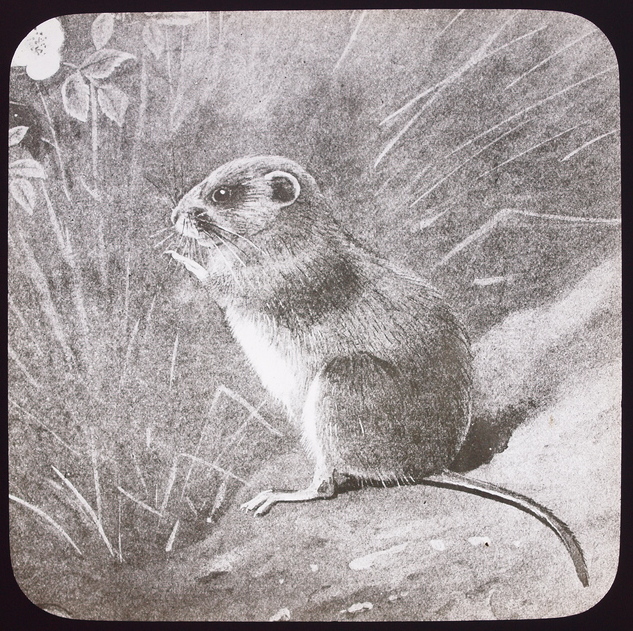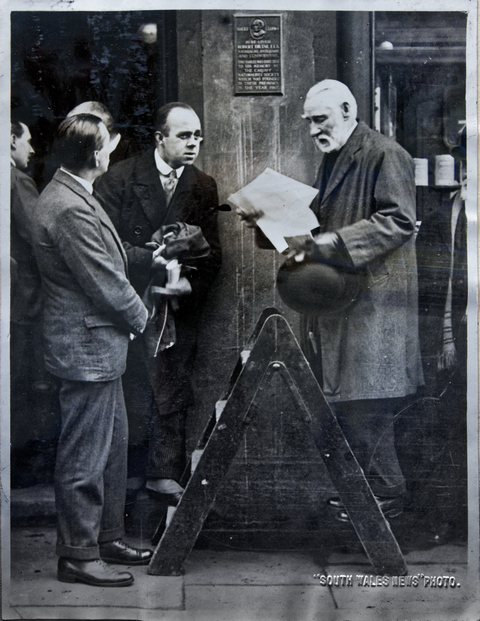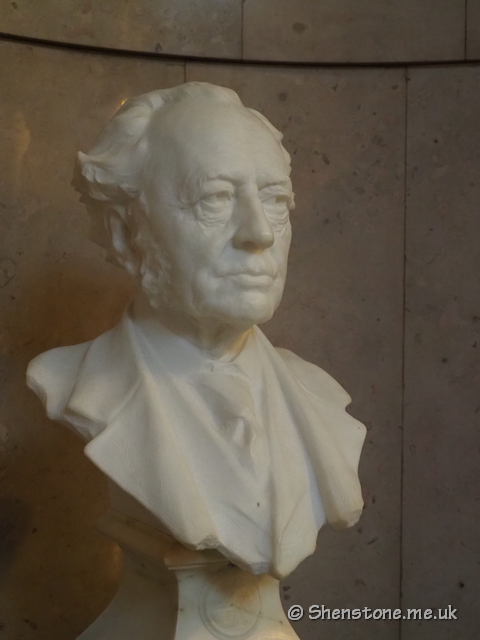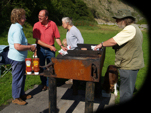
Cardiff
Naturalists' Society
Cymdeithas Naturiaethwyr
Caerdydd
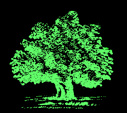
Robert Drane (1833-1914) Founder and 24th President
|
Back to the 150th Anniversary index Robert Drane is the person considered to be the founding father of the Cardiff Naturalists' Society, which was established according to many documented sources in his shop at 16 Queen Street, Cardiff in 1867. A chemist by trade he had a wide range of interests, including natural history, porcelain and antiquities and was probably best known in the public eye as an antiquary. Robert Drane was born on 21st August 1833 in Guestwick, near Reepham in Norfolk. His father was a congregational minister and Robert was one of his six children, two of which died in early childhood. In July 1849 he became an apprentice chemist with a Mr Francis in Woodbridge, Surrey but remained only for about 4-5 weeks. In September of the same year he became an apprentice to Mr Smith, a chemist in Magdalene Street, Norwich where he stayed to complete his four-year apprenticeship and joined the Pharmaceutical Society. 
Robert Drane (left) Talking to Joshua Neale On qualifying he became assistant at the Plough Court Pharmacy of Allan and Hambury's in London before, in 1858, moving to Cardiff. Here he set up his own pharmacy business at 11 Bute Street before moving to at 16 Queen Street in 1867. In the 1890s he opened a branch in Penarth but that was not as successful as his Cardiff shop. On his death, on 14th July 1914, his shop was given equally to his four assistants. Drane had a strong interest in ceramics and was an acknowledged authority on porcelain, especially Old Worcester, of which he had an acknowledged collection. He worked with William Turner on a history of the ceramic factories of Swansea and Nantgarw which was published in 1897 under the title The Ceramics of Swansea and Nantgarw: A history of the factories with biographical notices of artists and others, notes on the merits of the porcelains, the marks thereon etc with An Appendix on the Mannerisms of the Artists by Robert Drane. 
Robert Drane As well as amassing a collection of his own, Drane was also asked to purchase samples of pottery from the Swansea and Nantgarw potteries for the Cardiff Museum, which today are in the collections of the National Museum of Wales. From 1895-97 he presented several pieces of Welsh porcelain and pottery to the museum and, in 1899, lent his collection to the museum and compiling a catalogue to go with it. In 1902 he advocated for the purchase of type-specimens of English pottery by the museum and in 1903 presented many pieces for this collection. Amongst his other non-natural history hobbies were collecting old spoons, Old English drinking vessels, early English needlework some glassware, books, and antiquarian oddities, especially those that demonstrated the ‘development of religious myths’. In 1857 he published a small brochure on Castell Coch : A gossiping companion to the ruin and it’s neighbourhood’ for which his sister produced the plans and drawings. 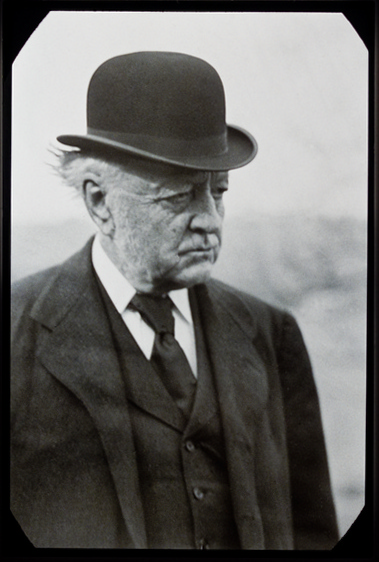
Robert Drane Like his ceramic and antiquarian collecting his natural history interests were also varied. Between 1856 - 1860 he assisted in the preparation of what was to become a multi-volume work on micro-lepidoptera, the Natural History of the British Tineina (Clothes moths) by H. T. Stainton. In the Entomologist's Annual of 1858 he is listed as an entomologist living at 11 Bute Street, Cardiff. Drane's taste for natural history appeared early and was probably developed by the training in botany which he received. Soon after settling in Cardiff he instituted a class for the study of field botany, which he conducted twice a week at 7.0 a.m. in the Sophia Gardens. He also made a collection of local birds, many of which he stuffed himself. These were presented to the museum and included specimens of the Rusty Grackle and Pallas' Great Grey Shrike, both of which were first records of these species in Britain. The shrike, now known to be a northern form of the Great Grey Shrike (Lanius excubitor) was shot in 1881 near Bridgend and the Rusty Grackle (now known as the Rusty Blackbird (Euphagus carolinus), was shot at East Moors, Cardiff also in 1881. Both were sent to Drane who had them stuffed. Doubt has since been cast upon the authenticity of the Rusty Blackbird as being a naturally occurring vagrant modern thinking being that it might be an escaped cage bird. His ornithological interests led to him serving on the Society's Committee that produced the first Birds of Glamorgan publication in 1898/99. 
Robert Drane plaque ready for siting Perhaps his most famous contribution to natural history was his recognition that the Skomer Vole (Myodes glareolus skomerensis) was a different race of the Bank Vole (Myodes glareolus) to that found on the mainland. This came after a visit to the island in 1898, during which he collected a number of specimens which, on his return to Cardiff, he sent to the Linnean Society in London and the British Museum of Natural History (now the Natural History Museum). In 1903 Barrett Hamilton of the British Museum of Natural History confirmed that the voles were indeed a different race. On 24th April 1905 he brought live voles back from Skomer so that he could study them in his house. The keeping of live animals for study included voles, field mice and tame hares, the latter having the free-run of his house above the shop. His study on the hares culminated in the publication of The Hare in Captivity in 1881. Skomer Vole as shown to the Society on a glass Lantern Slide Robert William Atkinson 22nd and 54th President unveiling the Drane Plaque (from Society Archives) 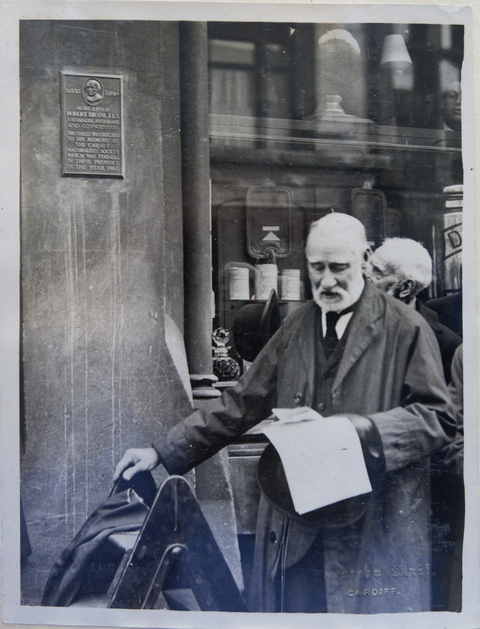
Robert William Atkinson 22nd and 54th President unveiling the Drane Plaque (from Society Archives) 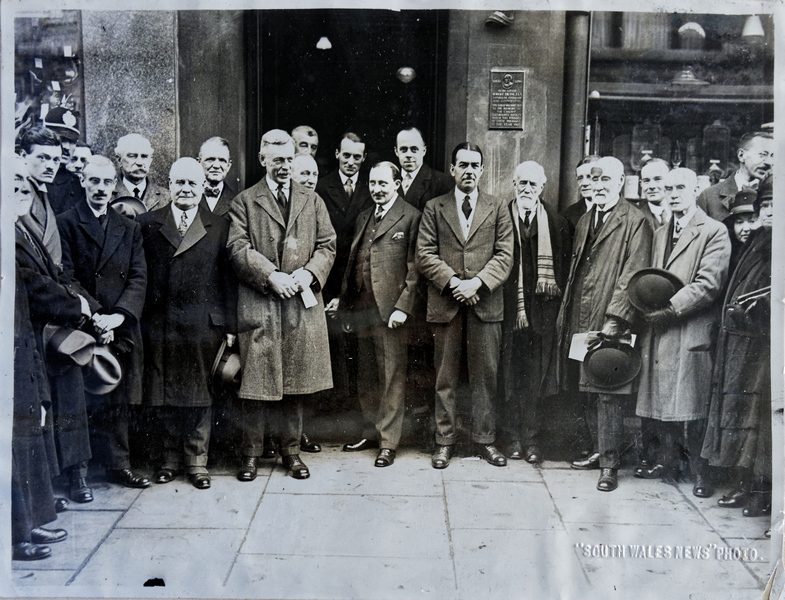
Robert Drane plaque unveiling Drane became President of the Cardiff Naturalists' Society for the 1896-97 year and a member of the Museum Committee soon after it was formed. He was well aware of the importance of making the institution a local museum and served as an Honorary Curator from 1867, always being consulted on purchases for the Antiquities section. With the creation of the National Museum of Wales in 1907 he was involved with the appointment of its first Director, William Evans Hoyle, and with the building plans. He died on 14th July 1914 and on 16th February 1927 the then President of the Cardiff Naturalists' Society, Robert William Atkinson , unveiled a plaque on the front of Drane's shop in Queen Street that read: B. 1833 D.1914 Here lived Robert Drane, F.L.S.,naturalist, antiquary and connoisseur. This tablet was erected to his memory by the Cardiff Naturalists' Society, which was founded in these premises in the year 1867. Unfortunately, the original plaque has been stolen by metal thieves. A replacement resin plaque was erected in its place by the members of the Society 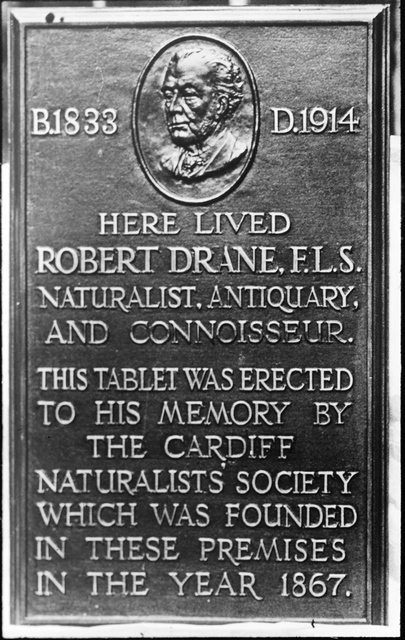
Robert Drane original plaque in detail All of this is the standard wisdom about Robert Drane, but some more research in the archives puts a slightly different light onto some of these facts and we appreciate the diligence of Tony Peters, Glamorgan Archives Volunteer in doing that extra work to provide this additional information Whatever the original facts about location and attendance at those formative meetings, it is certain that Robert Drane was a leading light in the early society and was instrumental in its continued success and a great contributor to local museums and it is fitting that his likeness is on show in the main hall of the National Museum of Wales, Cathays Park Main building. Bust of Robert Drane in marble created by Leonard Stanford Merrifield in 1910 and bequeathed by Drane in 1915 There is an extensive obituary of Robert Drane in volume XLVIII of the transactions which can be read via the National Library of Wales Scanned Journal Archive The text of that article is reprinted here: -
Page Update 12-Aug-2018 At the event when we hosted the Insole Court Tree Walk on Saturday on the 9th of June 2018, I was approached by one of the Insole Court research group about a possible picture of one of our former presidents. On finding that book "Contemporary Portraits Men and Women of South Wales and Monmouthshire, Western Mail Limited 1896" I found that it contained a number of portraits of our former presidents. 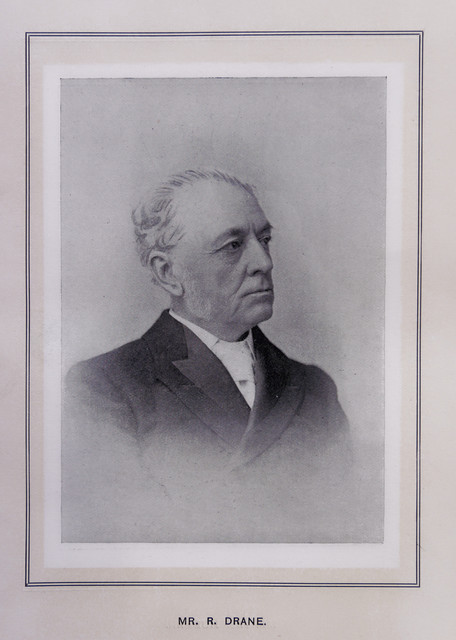
Robert Drane - from Contemporary Portraits Men and Women of South Wales and Monmouthshire, Western Mail Limited 1896 These pages are about our history and are celebrating the people who developed our Society over the last 150 years. You can read more about that using the links below Back to the 150th Anniversary index Before this... Reverend Canon Chas James Thompson (1836-1909) 23rd President Next up... John Tatham Thompson (1858-1911) 25th President See our Full list of Presidents If you want to read about the ways we study the wildlife and environment of the Cardiff area and its surroundings, and about the talks we have about the wildlife of the world, and find the programme of talks, walks and other events that we do then please take a look at our main website, our blog and our facebook and twitter feeds for up to date news |
